Quinn Surname Ancestry ResultsOur indexes 1000-1999 include entries for the spelling 'quinn'. In the period you have requested, we have the following 557 records (displaying 151 to 160): Single Surname Subscription | | | Buying all 557 results of this search individually would cost £3,372.00. But you can have free access to all 557 records for a year, to view, to save and print, for £100. Save £3,272.00. More... |
These sample scans are from the original record. You will get scans of the full pages or articles where the surname you searched for has been found. Your web browser may prevent the sample windows from opening; in this case please change your browser settings to allow pop-up windows from this site. Dublin Electors
(1865)
This alphabetical list of electors for the City of Dublin for 1865 is annotated with details of the votes cast in the election of 15 July 1865 for a member of Parliament. The candidates were John Vance, Esq., D. L. (V), Benjamin Lee Guinness, Esq., D. L., LL. D. (G), and Jonathan Pim, Esq. (P). The first column gives, in bold, the initial of the ward in which lay the property that was the elector's qualification. The second column gives the elector's sequential number (alphabetically) within that ward. Then the elector's full name is given, surname first, and address, usually including house number. The votes cast are shown on the right: where these columns are blank, the elector did not vote. The key to the ward names is: A, South Dock; B, Donnybrook; C, Rathdown; D, Trinity; E, South City; F, Royal Exchange; G, Mansion House; H, Fitzwilliam; I, Wood Quay; K, Merchants' Quay; L, Usher's Quay; M, Arran Quay; N, Inns' Quay; O, North City; P, Rotundo; Q, Mountjoy; R; North Dock. S indicates the register of freemen.QUINN. Cost: £4.00.  | Sample scan, click to enlarge
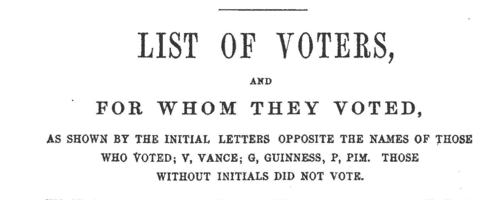
| Dublin University Electors
(1868)
The roll of all persons entitled to vote at elections for members to serve in Parliament for the University of Dublin lists living graduates of the university, arranged alphabetically by surname and christian name(s), with current residence, dates at which their degrees were conferred - Vern. denoting the Spring, Aest. the Summer, and Hiem. the Winter Commencements - and date of registration. Members of the Senate and electors on the books of Trinity College are distinguished by a dagger. Where an elector's name is given in italics, he was no longer known at the residence given.QUINN. Cost: £4.00.  | Sample scan, click to enlarge

| Electors for Lapworth
(1868)
A poll for the election of two knights of the shire to represent South Warwickshire was held 24 November 1868: the candidates were Lord Hyde (H.), Sir R. N. C. Hamilton (H.), H. C. Wise, Esq. (W.) and John Hardy, Esq. (H.). This poll book lists all those electors who voted; the county franchise included not only male freeholders of 40s a year, but also £10 copyholders and long-leaseholders, and £50 short-leaseholders and tenants. In addition, where no vote was cast the elector's number and name are given, the name in italics. The names are arranged by polling district and then by parish or township. Freeholders holding requisite property in a district are listed there, but might well reside elsewhere. The right-hand column indicates how each man voted. QUINN. Cost: £4.00.  | Sample scan, click to enlarge
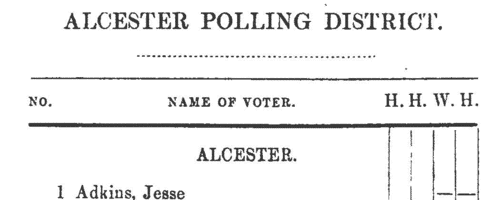
| Inhabitants of Worcester
(1868)
Gentry, farmers and traders listed in J. E. R. Kelly's Post Office Directory of Worcestershire. (The sample scan is of the section for the little parish of Hadzor)QUINN. Cost: £6.00.  | Sample scan, click to enlarge

| Science Schools and Classes: Elementary Examination: Class Lists
(1869)
The Science and Art Department of the Committee of Council on Education published these class lists giving the names of all the successful candidates in the examination of science schools and classes taken in May 1869. The candidates were of three levels: honours; second stage or advanced examination; third stage or elementary examination. Twenty-three subjects were offered. These are the lists for the elementary examination. The tables, arranged subject by subject, give the candidate's full name (surname first), age, and occupation - or, in the case of those not yet of working age, father's occupation, preceded by (f.). Many candidates sat and were successful in more than one subject, and so appear in more than one list. The subjects are: I. Practical, Plane and Solid Geometry; II. Machine Construction; III. Building Construction; IV. Elementary Mathematics; V. Higher Mathematics; VI. Theoretical Mechanics; VII. Applied Mechanics; VIII. Acoustics, Light, and Heat: IX. Magnetism and Electricity; X. Inorganic Chemistry; XI. Organic Chemistry; XII. Geology; XIII. Mineralogy; XIV. Animal Physiology; XV. Zoology; XVI. Vegetable Anatomy and Physiology; XVII. Systematic and Economic Botany; XVIII. Mining; XIX. Metallurgy; XX. Navigation; XXI. Nautical Astronomy; XXII. Steam; XXIII. Physical Geography. QUINN. Cost: £6.00.  | Sample scan, click to enlarge

|  Outstanding soldiers of the 10th regiment of Foot
(1860-1870) Outstanding soldiers of the 10th regiment of Foot
(1860-1870)
The 10th (The North Lincolnshire) Regiment of Foot was in two battalions. The 1st battalion returned from India in 1859, and in 1860 was at Plymouth. The home depot was at Devonport. The second battalion was sent abroad in 1859, and by 1860 was serving at the Cape of Good Hope: it was transferred to India in 1864. Each year just a handful of outstanding soldiers of the regiment were chosen for good conduct medals and gratuities: these are listed here. There were two lists, one for men recommended for the Good Conduct Medal without a gratuity, and one for gratuities - £5 to a private, £10 to a corporal, and £15 to a serjeant. Both lists are indexed here, and each gives rank, name, regimental number, date of recommendation and date of issue. (The sample scan is from the 105th foot)QUINN. Cost: £8.00.  | Sample scan, click to enlarge
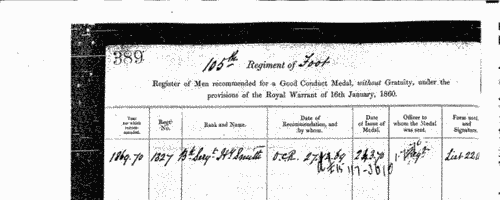
|  Outstanding soldiers of the 12th regiment of Foot
(1860-1870) Outstanding soldiers of the 12th regiment of Foot
(1860-1870)
The 12th (East Suffolk) Regiment of Foot was in two battalions. The 1st battalion embarked for Australia and Tasmania in 1854, and was moved to New Zealand in 1863, taking part in the conflict there; and returning home to England in 1867. The home depot was at Walmer. The second battalion returned from the Cape of Good Hope in 1858, and in 1860 was at Aldershot. Each year just a handful of outstanding soldiers of the regiment were chosen for good conduct medals and gratuities: these are listed here. There were two lists, one for men recommended for the Good Conduct Medal without a gratuity, and one for gratuities - £5 to a private, £10 to a corporal, and £15 to a serjeant. Both lists are indexed here, and each gives rank, name, regimental number, date of recommendation and date of issue. (The sample scan is from the 105th foot)
QUINN. Cost: £8.00.  | Sample scan, click to enlarge
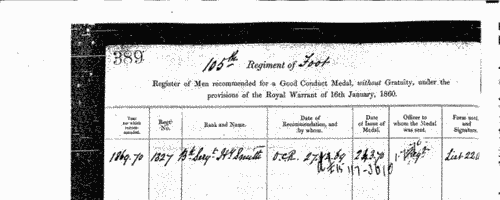
|  Outstanding soldiers of the 14th regiment of Foot
(1860-1870) Outstanding soldiers of the 14th regiment of Foot
(1860-1870)
The 13th (The Buckinghamshire) Regiment of Foot was in two battalions. The 1st battalion embarked for Malta in 1854, and served successively in the Crimea and the Ionian Islands, being transferred from Corfu to the West Indies in 1860. The home depot was at Fermoy in Ireland. Having returned to England in 1862, the battalion was moved to Ireland in 1866, and to India in 1867. The second battalion was raised in Ireland in 1857; was at Mullingar in 1860; and was sent to New Zealand, taking part in the war of 1863 to 1865. In 1866 the battalion was moved to Australia and Tasmania, returning to England in 1870. Each year just a handful of outstanding soldiers of the regiment were chosen for good conduct medals and gratuities: these are listed here. There were two lists, one for men recommended for the Good Conduct Medal without a gratuity, and one for gratuities - £5 to a private, £10 to a corporal, and £15 to a serjeant. Both lists are indexed here, and each gives rank, name, regimental number, date of recommendation and date of issue. (The sample scan is from the 105th foot)QUINN. Cost: £8.00.  | Sample scan, click to enlarge
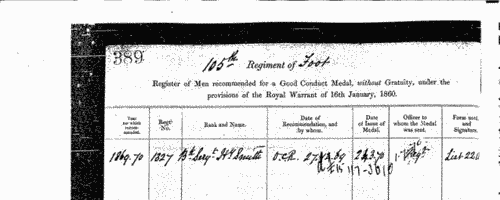
|  Outstanding soldiers of the 83rd regiment of Foot
(1860-1870) Outstanding soldiers of the 83rd regiment of Foot
(1860-1870)
The 83rd Regiment of Foot embarked for Bombay in January 1849, and took part in the suppression of the Indian Mutiny, adding "Central India" to the regimental colours. It returned to England in 1862: the regimental depot was at Chichester. In 1866 the regiment was sent to Ireland, in 1867 to Gibraltar, and in 1870 back to India. Each year just a handful of outstanding soldiers of the regiment were chosen for good conduct medals and gratuities: these are listed here. There were two lists, one for men recommended for the Good Conduct Medal without a gratuity, and one for gratuities - £5 to a private, £10 to a corporal, and £15 to a serjeant. Both lists are indexed here, and each gives rank, name, regimental number, date of recommendation and date of issue. (The sample scan is from the 105th foot)QUINN. Cost: £8.00.  | Sample scan, click to enlarge
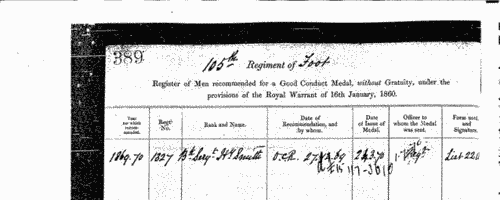
|  Outstanding soldiers of the 84th regiment of Foot
(1860-1870) Outstanding soldiers of the 84th regiment of Foot
(1860-1870)
The 84th (York and Lancaster) Regiment of Foot returned to England from India in 1859: the regimental depot was at Pembroke, and the troops were stationed at Sheffield. In 1865 the regiment was sent to Malta; in 1867 on to Jamaica; and in 1870 to Halifax, Nova Scotia. Each year just a handful of outstanding soldiers of the regiment were chosen for good conduct medals and gratuities: these are listed here. There were two lists, one for men recommended for the Good Conduct Medal without a gratuity, and one for gratuities - £5 to a private, £10 to a corporal, and £15 to a serjeant. Both lists are indexed here, and each gives rank, name, regimental number, date of recommendation and date of issue. (The sample scan is from the 105th foot)QUINN. Cost: £8.00.  | Sample scan, click to enlarge
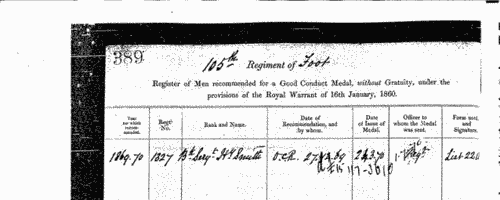
|
Research your ancestry, family history, genealogy and one-name study by direct access to original records and archives indexed by surname.
|













